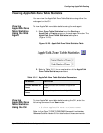
16-2
Chapter 16
Cajun P550/P880/P882 Switch User Guide
A client port is a port with an attached host configured to receive a
multicast session.
Router ports are ports that are attached to (or in the path to)
multicast routers and must be treated specially. All multicast traffic
on a VLAN must be forwarded to the router.
You can manually create and delete multicast sessions through the
user configuration. The addition of client and router ports can also
be performed manually. Dynamic intelligent multicasting is
achieved through Internet Group Management Protocol (IGMP)
snooping, Lucent Group Membership Protocol (LGMP), or Cisco
Group Management Protocol (CGMP) snooping. All of these
mechanisms are based on the assumption that the client host is
running IGMP, requesting membership in the IP multicast session.
* Note: If there is no multicast session created for a multicast
flow in a VLAN, then that multicast flow will be flooded
to all ports on the VLAN. Intelligent multicasting must
be enabled for any dynamic intelligent multicasting to be
active.
Layer 3 Dynamic Intelligent Multicasting
IGMP snooping is supported for VLANs that have IGMP interfaces
enabled. This is the recommended means of supporting dynamic
intelligent multicasting in layer 3. For all VLANs that do not have an
IGMP interface enabled, the layer 2 dynamic intelligent multicasting
mechanisms (LGMP client and CGMP snooping) are supported.
* Note: For layer 2 or layer 3 LGMP to perform properly, VLAN
IDs must match between switches. Specifically, if two
switches are connected with a non-tagging link, the
port-default VLANs of the ports connecting the two
switches must be the same. This is because the VLAN is
embedded in the LGMP message; and the receiving
switch maps the LGMP message to the specified VLAN.


















